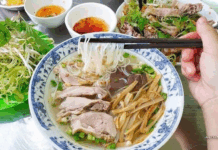 |
| A bowl of Nam Pho “banh canh”. |
Nam Pho banh canh is a kind of soup with origins in Nam Pho Village in Phu Vang District, Thua Thien – Hue Province, which is famous for its rich culinary specialties thanks to the benefits of the Tam Giang – Cau Hai lagoon system.
According to the local people, special features in the core and pistil of Hue’s specialties come from this lagoon system. Nam Pho banh canh is no exception, with the sweetness of the broth and the filling made from shrimp and crab.
Certainly, it is not easy to cook a pot of delicious Nam Pho banh canh, like many other specialties of Hue Ancient City.
Firstly, rice flour and finest flour must be mixed according to the appropriate ratio. After that, the flour must be steamed and stirred evenly until a thick consistency is achieved. Then, the mixture will be put in a bag and poured through a small hole into a pot of seeping water. This is the step that creates the rounded shape of banh canh yarn. The finished product will be a pot of hot banh canh absorbing the viscous and flexible broth.
The broth, which is made from the boiling of rice and filter flours, is also an indispensable part of a Nam Pho banh canh pot. A portion of this broth is boiled with the shrimp and crabsoup, to which spices, cooking oil and onions are added to create a delicious flavour.
The boiled shrimps and crabs are peeled and crushed with raw sausages to make rolls. At the same time, purple onions are stir-fried with cashew oil and heated with the boiled broth. When this mixture begins boiling, the crab and shrimp rolls will be added into the pot.
Viewed from above, half of the Nam Pho banh canh pot is white rice flour while the remainder contains eye-catching red fillings.
All scallions, flagrant knotweed, chopped red and green chili, abottle of delicious fish sauce, a few lemons and dozens of bowlsand spoons are put in one side of shoulder poles and hangers and the pot of banh canh is placed on a small coal stove to keep it hot. From Nam Pho Village, the loads of banh canh go around the alleyways of Hue Ancient City.
In the old days, the announcement of “Let’s enjoy Nam Pho banh canh” was considered the alarm bell time for the twilight meal. Because of its complicated preparation, the batches of Nam Pho banh canh often appeared from the afternoon.
On co bld rainy days, a bowl of warm Nam Pho banh canh dotted with scallions and flagrant knotweed and mixed with chili fish sauce will be a pleasant experience. NDO



